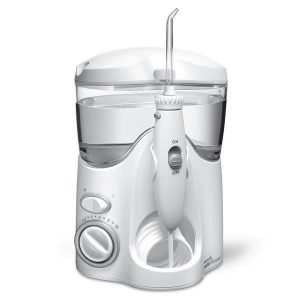Let’s talk about how to use a Waterpik. After all, it’s essential to clean between your teeth, and doing so properly can be difficult.
Water flossers like Waterpik clean faster and easier than dental floss, which has been the norm for a long time. Many people also find them to be more convenient and comfortable to use than floss.
However, using a Waterpik can also be messy. Fortunately, as with anything else, practice makes perfect.
We hope this article will help you to refine your water flossing technique. If you haven’t got a Waterpik yet, we also recommend you check out our article on the best water flossers.
How to use a Waterpik without making a mess
Here’s how to use a Waterpik water flosser in four easy-to-follow steps.
- Step 1 — Fill the water tank: You may have a self-contained water reservoir or one that connects to your faucet through a hose. Consider using somewhat warm water to prevent causing temperature shock to your teeth. Also, ensure sure the lid is closed. You don’t want all that extra water splattering all over the place.
- Step 2 — Choose a water flosser head type: A standard tip is included with most water flossers. Others have additional features or various designs to clean around braces. When in doubt, and especially when learning how to operate a water flosser, use the default design tip. Make sure it’s properly attached. As you gain confidence, you may begin to experiment with the other tips.
- Step 3 — Choose a pressure level: You should look for a water flosser with dials or knobs for adjusting the water pressure. If this is your first time using a water flosser, keep it on the low to medium setting.
- Step 4 — Floss: Lean over the sink with your lips barely open before you begin. Place the stream where your gumline meets your teeth. Ideally, the stream should be angled 90 degrees into your gums. Trace your gums, stopping briefly at the gaps between your teeth. The surplus water will continue to run out of your mouth and into the sink. Don’t glance up in the mirror (otherwise, you’ll end up with a large mess to clean up later!)


When you switch on the water flosser, you should feel a gentle massage rather than a harsh pressure. If you want a stronger jet of water, gradually increase the dial setting. Reduce the pressure if it hurts your gums.
Using a Waterpik water flosser can be very messy. However, with a little experience, it won’t seem as if you’re brushing your teeth with a wild fountain.
And for extra gum care, you can sometimes fill your Waterpik with a diluted solution of hydrogen peroxide.
Waterpik instructions video
If you’re more of a visual learner, this video provides a good explanation of the proper steps to take:
Conclusion
Using a Waterpik water flosser can be very messy at first. To stop the water from going everywhere, make sure you are always bent over the sink, and that you keep your mouth slightly open so the water can drip out of your mouth, and into the sink.


While you might be tempted to look at yourself in the mirror to see what’s going on, resist the urge, as this will cause water to go everywhere.
You’ll also notice that if you aim the spray incorrectly, it can definitely hurt. So make sure to only turn the stream of water on once you have the tip positioned along your gumline.
Also, if you have tonsil stones, find out how to remove them in our article about the best Waterpik for tonsil stones.
FAQ
How often should you use a Waterpik?
The American Dental Association recommends flossing at least once per day. Cleaning regularly between your teeth will help to maintain good oral hygiene and help to prevent gum disease and cavities.
Can you use a Waterpik too much?
You can use a Waterpik as often as you want without risk. If you have gum disease, your dentist may advise you to use a Waterpik more often than once a day to enhance your dental hygiene.
Do I need to floss if I use a Waterpik?
A Waterpik may help remove food particles from your teeth and may help prevent bleeding and gum disease, but it’s not a replacement for brushing and flossing.


What is a Waterpik used for?
A Waterpik, or water flosser, also sometimes called an oral pulsating irrigator, is a device that sprays water at your teeth. It helps to remove food particles from between your teeth.
Can you put saltwater in a Waterpik?
Yes, to assist in removing germs from within gum pockets, your dentist may recommend using warm saltwater in a water flosser. The water flosser can help get the solution to hard-to-reach places.
If you can’t get to the germs in your gum pockets, your gingivitis will only grow worse.
How effective are water flossers?
According to a study, plaque removal from tooth surfaces is substantially more efficient with the Waterpik water flosser and manual toothbrush than with a manual brush and string floss.


How to properly use a Waterpik?
Switch on the Waterpik. To avoid splashing, partially shut your lips. Allow water to run freely from your lips into the sink. For optimal results, aim the tip towards the gum line.
Can you use a Waterpik instead of flossing?
A Waterpik water flosser may help remove food particles from your teeth and may help prevent bleeding and gum disease, but it’s not a replacement for brushing and flossing.
Using a Waterpik doesn’t usually remove visible plaque and film from your teeth, but it may help reduce germs below the gumline.
How can I use a Waterpik with implants?
Waterpiks utilize a constant stream of water to reach areas where flossing cannot, such as around implants, between teeth, and under gumlines. Just trace the Waterpik around each implant and tooth.
Also, take your time to clean the regions near the gums and pause between each tooth.
How to use a Waterpik for periodontal disease?
Lower the pressure on the Waterpik water flosser. Place the tip at a 45-degree angle beneath the gumline and into the pocket gently. Turn on the device and draw a line along the gumline.
Pubmed.ncbi.nlm.nih.gov: Evaluation of the plaque removal efficacy of a water flosser. Consulted 07 June 2022.
Mouthhealthy.org: Flossing. Consulted 07 June 2022




